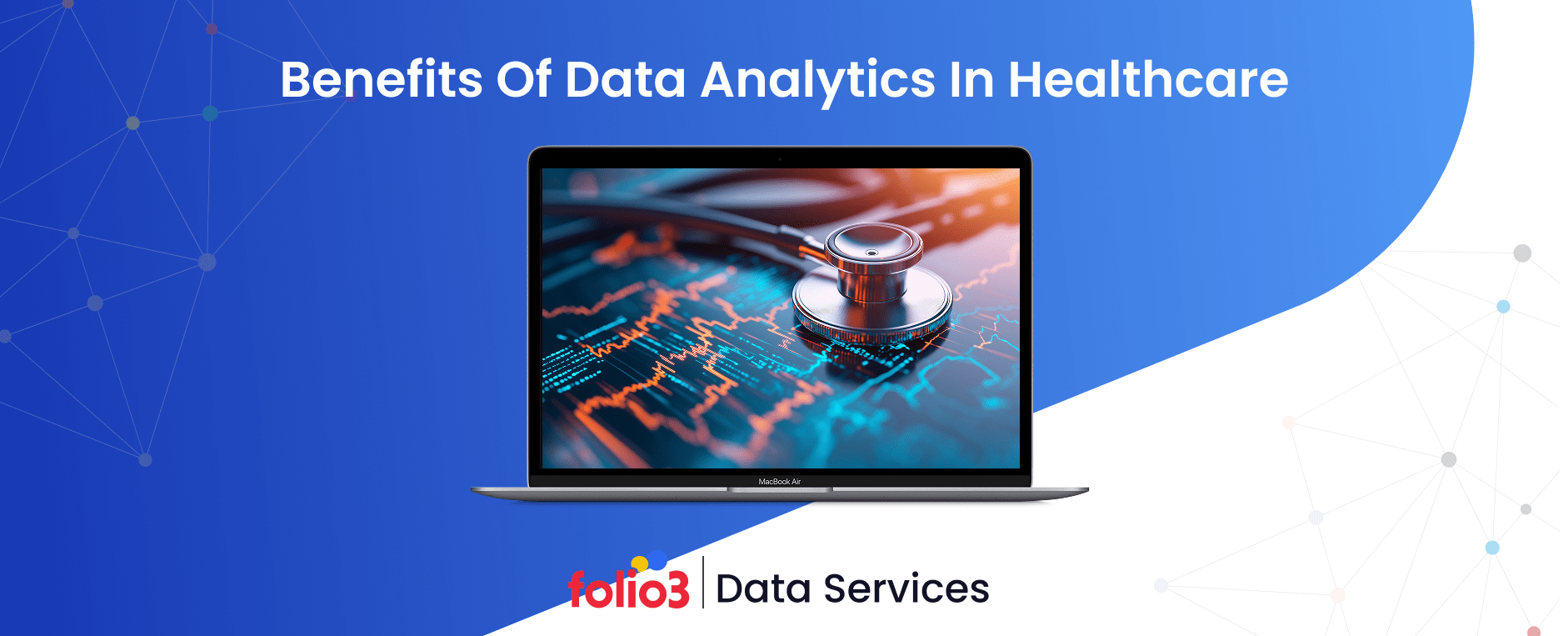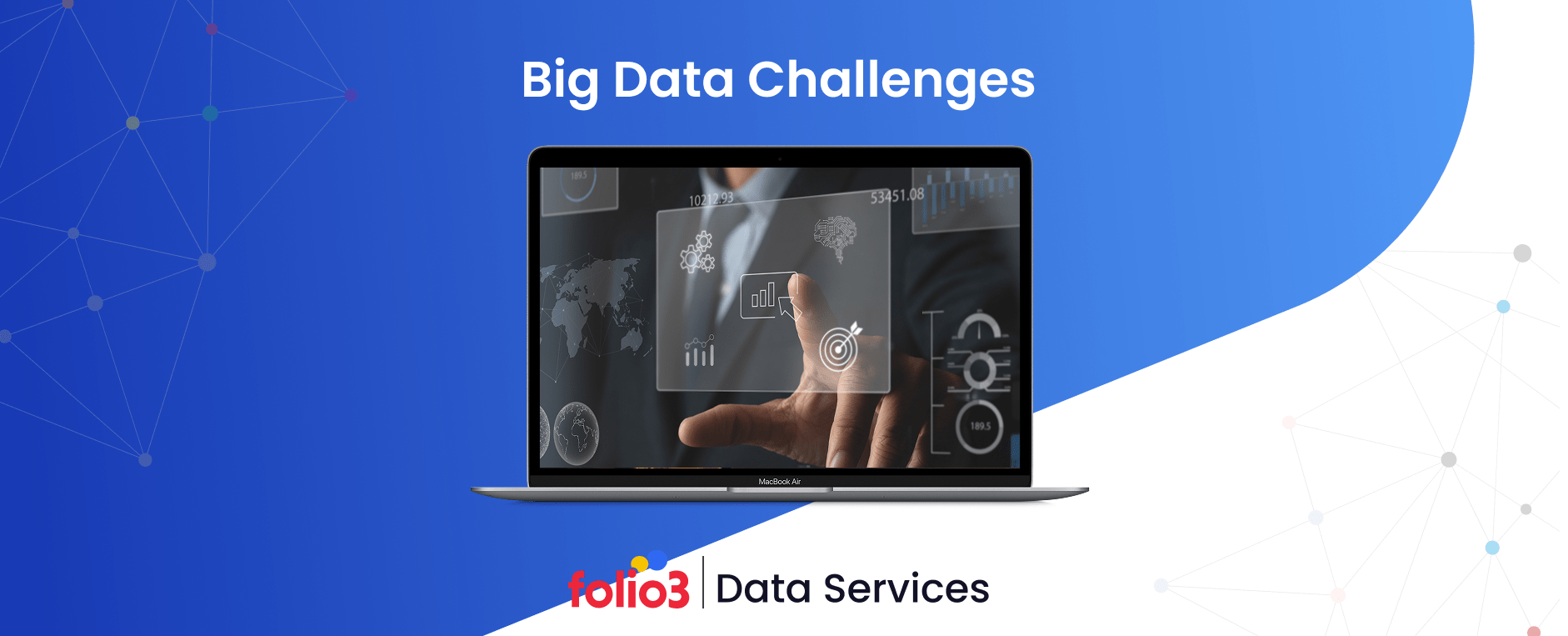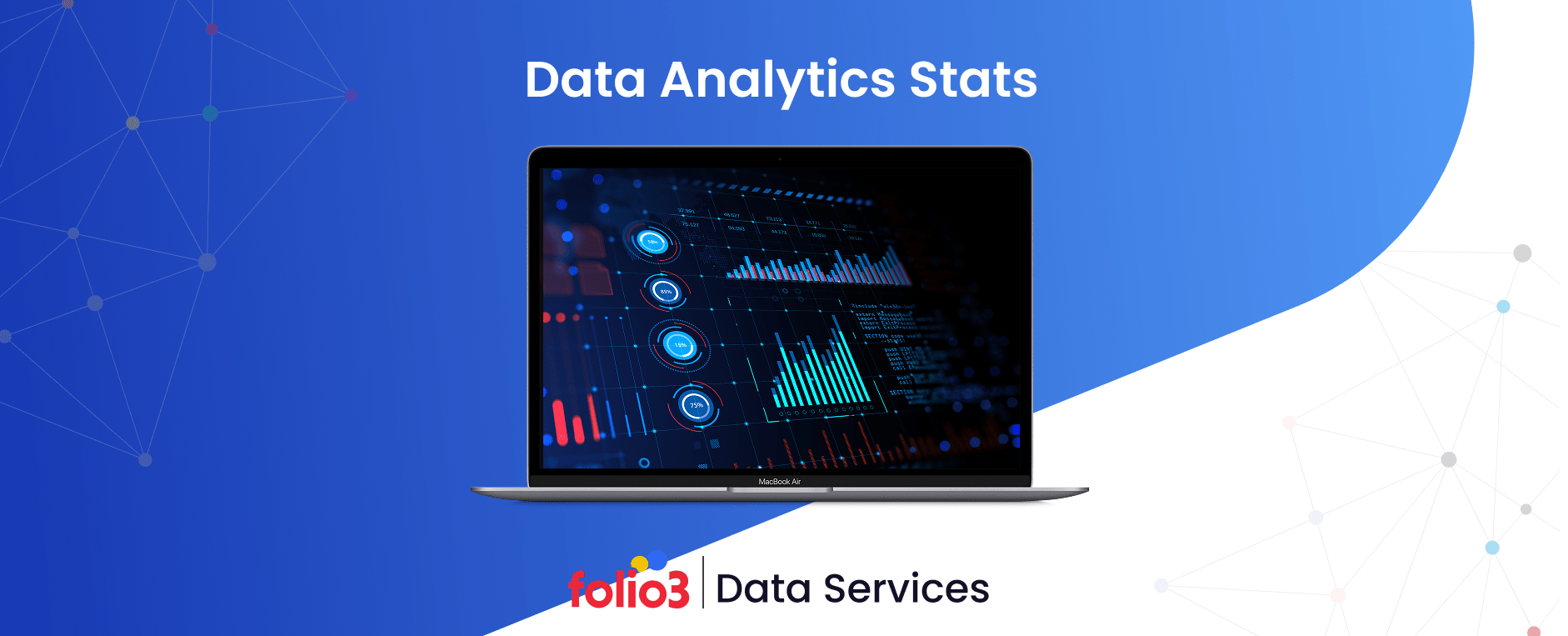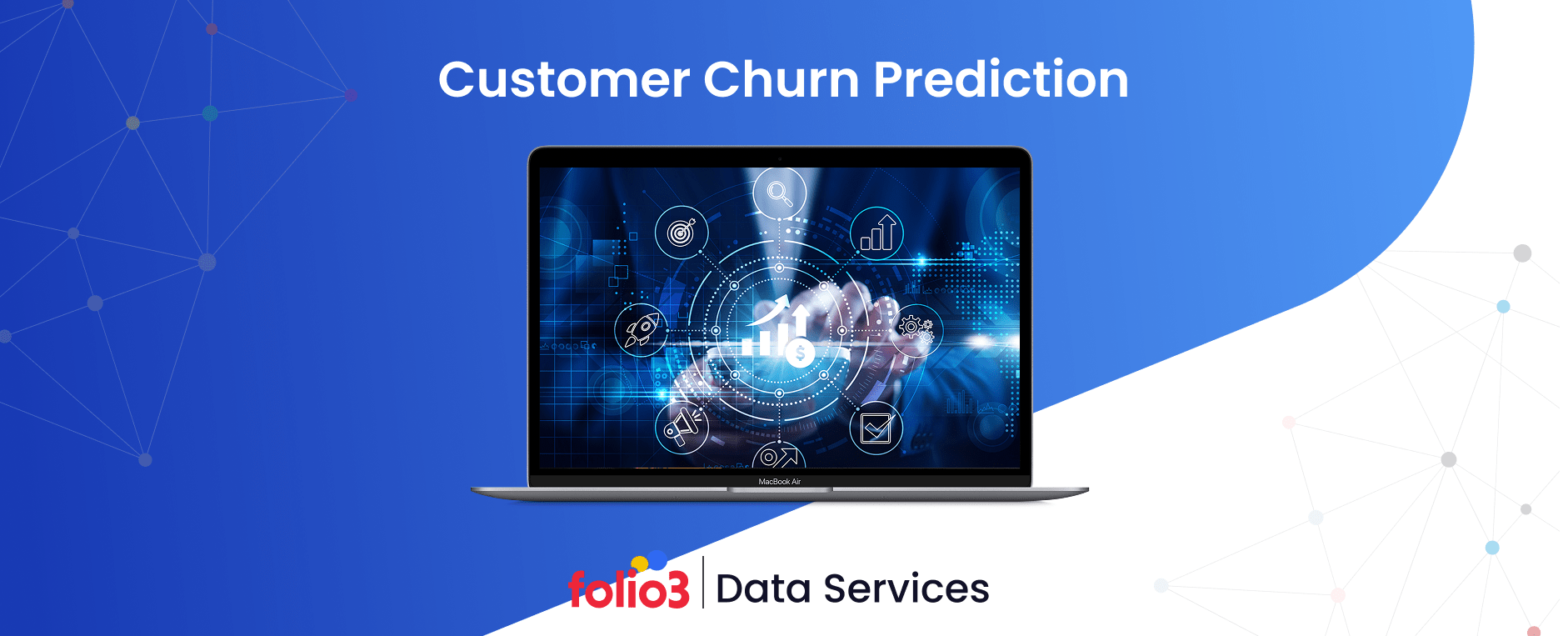Healthcare is generating more data than ever before, and using it wisely can mean the difference between reactive treatment and proactive care. With over 30% of the world’s data being produced by the healthcare industry alone, the ability to analyze and interpret this information is becoming essential for smarter, safer, and more efficient decision-making.
From predicting disease outbreaks to reducing hospital readmission rates, data analytics is quietly reshaping how healthcare systems operate and how care is delivered. One of the most critical benefits of data analytics in healthcare is its role in improving patient outcomes.
By identifying patterns in patient histories, lab results, and treatment plans, clinicians can make more informed decisions faster. At the same time, hospital administrators are using analytics to cut costs and improve resource allocation, a pressing need when global healthcare spending is expected to reach $13.4 trillion by 2030.
This blog explores the practical advantages of healthcare data analytics from reducing diagnostic errors to supporting personalized medicine, and how it’s helping providers turn raw data into real results.
What is Healthcare Data Analytics?
Healthcare data analytics refers to the process of examining vast amounts of health-related data to uncover trends, draw insights, and support evidence-based decision-making. It involves collecting, organizing, and analyzing data from various sources such as electronic health records (EHRs), medical imaging, lab results, insurance claims, wearable devices, and even patient feedback.
This practice isn’t just about crunching numbers but it’s about making sense of complex health information to improve clinical, operational, and financial outcomes. For example, healthcare professionals use data analytics to monitor patient recovery rates, track the effectiveness of specific treatments, and predict potential health complications before they occur.
Whether it’s guiding clinical decisions or optimizing hospital workflows, healthcare data analytics is playing a key role in driving smarter, more data-informed care. There are several types of analytics used in the healthcare industry:
- Descriptive analytics helps summarize past events, like analyzing hospital readmission rates.
- Predictive analytics uses historical data to forecast future outcomes, such as identifying patients at risk of chronic disease.
- Prescriptive analytics suggests possible actions based on predictive outcomes, helping doctors choose the most effective treatment paths.
Why is Data Analytics Important in Healthcare?
Data analytics is becoming essential in healthcare because it enables providers, administrators, and policymakers to make faster, smarter, and more informed decisions. As the volume of health data continues to grow from electronic health records (EHRs) and diagnostic imaging to patient monitoring devices and genomic data, so does the need to understand and apply that information meaningfully.
One of the biggest reasons data analytics matters in healthcare is its ability to improve patient outcomes. By analyzing data trends, clinicians can detect early warning signs, personalize treatments, and reduce the risk of complications. For instance, predictive analytics can help identify patients at high risk of hospital readmission, enabling targeted interventions before problems escalate.
Keeping up with emerging data analytics trends allows healthcare systems to adopt new tools and methodologies that improve both care delivery and operational workflows. Beyond clinical care, data analytics also supports operational efficiency. Hospitals can optimize staff scheduling, manage supply chains, and reduce unnecessary tests or procedures, all of which help control rising healthcare costs. In public health, analytics has proven crucial for tracking disease outbreaks, allocating resources, and shaping policy decisions during crises like the COVID-19 pandemic.
7 Key Benefits of Data Analytics in Healthcare
The true power of healthcare data isn’t in how much is collected, it’s in how it’s used. From clinical decision-making to hospital operations, data analytics is reshaping the healthcare experience at every level. This section explores the most impactful, real-world benefits of healthcare data analytics not just in theory, but in ways that directly improve patient care, reduce costs, and support more innovative strategies for the future.
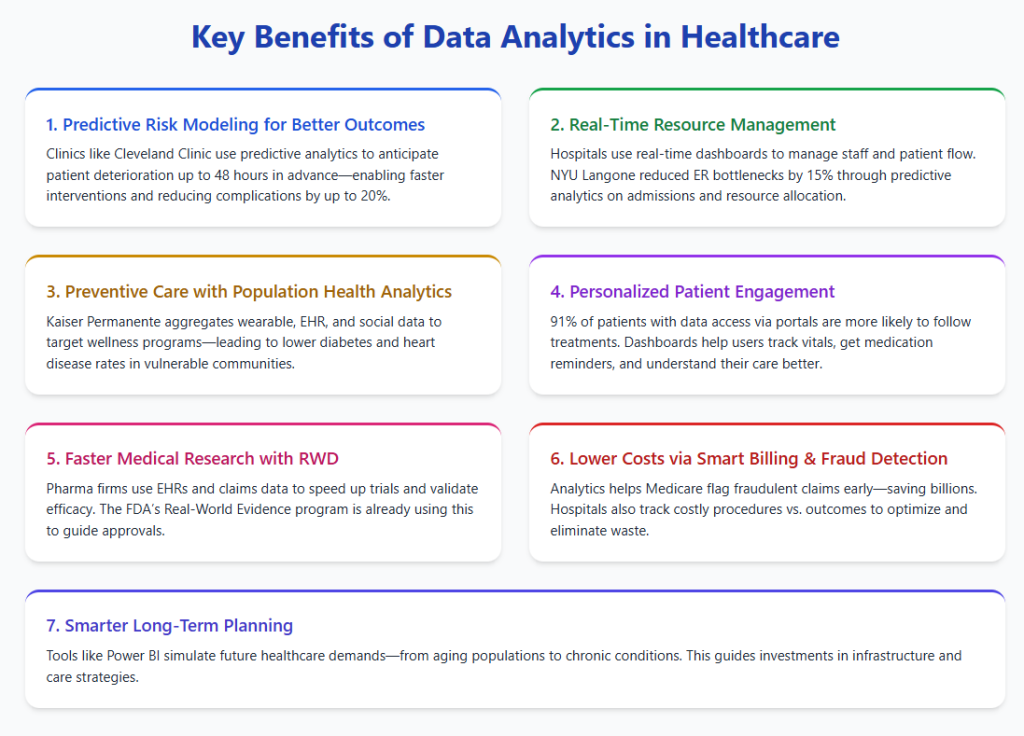
1. Improved Patient Outcomes Through Predictive Risk Modeling
Instead of waiting for symptoms to escalate, healthcare providers can now use predictive analytics techniques to intervene early. For example, the Cleveland Clinic uses machine learning algorithms to predict patient deterioration up to 48 hours before traditional clinical signs emerge. This allows physicians to act faster, often preventing ICU transfers or worse outcomes. This kind of analytics-based early warning system has been linked to up to a 20% reduction in preventable complications.
2. Enhanced Operational Efficiency with Real-Time Resource Management
Hospitals deal with constant pressure to balance patient loads, staff scheduling, and equipment availability. Using real-time analytics, some hospitals now run dashboards that predict Emergency Department wait times based on current admissions, staffing levels, and historical trends. For instance, NYU Langone Health has reportedly reduced ER bottlenecks by 15% using data to forecast patient inflow and shift resources better accordingly.
3. Preventive Care Backed by Population Health Analytics
By aggregating patient data from wearables, EHRs, and socioeconomic factors, health systems can identify communities at high risk for chronic diseases. Kaiser Permanente uses such data to proactively enroll at-risk patients into wellness programs, which has resulted in a measurable decline in diabetes and heart disease rates among enrolled populations. This shift from reactive to preventive care has not only improved health outcomes but also reduced long-term costs as well.
4. Improved Patient Engagement and Personalized Experience
Healthcare analytics isn’t just for doctors and administrators. Patients, too, are interacting with their own health data in meaningful ways. Personalized dashboards in patient portals can now provide medication reminders, track vitals from wearables, and deliver customized educational content. A survey by Accenture found that 91% of patients who had access to their medical records were more likely to follow their treatment plans.
5. Accelerated Medical Research Using Real-World Data (RWD)
Clinical trials are often expensive and time-consuming, but big data in healthcare offers a shortcut. Pharmaceutical companies now use real-world data from EHRs and claims databases to identify eligible trial candidates, simulate control groups, or even validate drug efficacy post-approval. The FDA’s Real-World Evidence Program, for instance, is already using healthcare data to support regulatory decisions.
6. Cost Reduction Through Intelligent Billing and Fraud Detection
Data analytics can spot billing anomalies and patterns that suggest fraud or waste. Medicare, for example, uses big data predictive analytics to detect suspicious claims before they’re paid out, saving billions annually. On the operational side, some hospitals use analytics to track high-cost procedures and compare them to patient outcomes, allowing administrators to eliminate or revise low-value practices.
7. Informed Long-Term Strategies Powered by Trend Analysis
Long-term planning in healthcare isn’t just about patient volumes—it’s about understanding trends in aging populations, disease prevalence, and resource demand. With tools like Tableau or Power BI, health systems can simulate future scenarios (e.g., an aging diabetic population in a rural area) and invest in infrastructure, staffing, and technology accordingly. Organizations that partner with expert data analytics services can create more resilient and data-informed strategies for the future.
Leverage actionable healthcare analytics to enhance patient care and optimize operations.
The Future of Patient Care With Healthcare Data Analytics
As healthcare continues to evolve, data analytics is playing a foundational role in shaping what comes next. The future of patient care isn’t just digital, it’s data-driven. From tailoring treatments to real-time remote monitoring, here’s how data analytics is paving the way forward:
AI and Machine Learning – From Diagnosis to Triage
Artificial intelligence (AI) and machine learning are no longer limited to labs—they’re actively supporting clinical decisions in hospitals. Algorithms trained on vast datasets can detect patterns that even seasoned specialists might miss. For instance, AI models like Google’s DeepMind have outperformed radiologists in identifying breast cancer from mammograms. These tools also help triage patients by predicting which cases are likely to escalate, demonstrating the growing impact of predictive analytics in healthcare. This enables faster intervention and better use of limited clinical resources.
Precision Medicine – Data-Powered Personalization
One-size-fits-all treatments are giving way to personalized care strategies. By analyzing genetic data, lifestyle factors, and medical history, healthcare providers can tailor therapies that are more effective and less prone to side effects. This is already being applied in oncology, where genomics-driven data analytics helps match cancer patients with targeted therapies that are more likely to work based on their individual biomarkers. A well-executed data analytics strategy is key to enabling this level of precision and personalization in care delivery.
Telemedicine and Remote Monitoring – Real-Time, Data-Rich Care
With the rise of wearable devices and home-based health tech, data analytics and digital transformation are enabling continuous monitoring of patients beyond the hospital walls. Metrics like heart rate, oxygen levels, and glucose can now be tracked 24/7, with anomalies triggering real-time alerts. This isn’t just convenient—it’s life-saving. Chronic patients, such as those with heart failure or diabetes, benefit from early detection of warning signs, reducing hospital readmissions and emergency visits.
Population Health Management – Data for Better Equity
Healthcare systems are using big data to understand and address health disparities across different communities. By analyzing social determinants of health (e.g., income, housing, education), organizations can design targeted interventions to improve care access and outcomes in underserved areas. This kind of population-level insight is essential for building more equitable, data-informed public health strategies.
Challenges and Strategic Considerations in Healthcare Analytics
While the benefits of healthcare data analytics are clear, implementation is far from straightforward. Real progress requires navigating a complex web of challenges, including privacy risks and technical gaps. Understanding these hurdles is essential for any organization aiming to use data responsibly and effectively.
Data Privacy and Security Concerns
Healthcare data is among the most sensitive types of personal information, and breaches can have serious consequences. Compliance with laws like HIPAA in the U.S. or GDPR in Europe adds additional complexity. In 2023 alone, healthcare organizations experienced more than 700 data breaches, affecting over 133 million individuals, according to HHS data. Encrypting data, securing APIs, and investing in advanced cybersecurity protocols are no longer optional, but they’re foundational.
Need for Skilled Workforce and Technology Investment
Analytics platforms are only as effective as the people using them. Many healthcare organizations struggle with a shortage of data scientists, analysts, and IT professionals who understand both tech and clinical contexts. Strategic hiring, upskilling current teams, and forming partnerships with analytics providers or consultants offering data strategy services are key considerations. Equally important is the need to invest in modern infrastructure like cloud-based platforms, interoperable systems, and scalable data warehouses.
Managing Data Quality and Interoperability
Incomplete or inconsistent data can skew analysis and lead to poor decision-making. Many health systems still operate across disconnected platforms, making it difficult to unify patient records or extract meaningful insights. Interoperability, the ability for systems to exchange and use data, remains a significant challenge, despite initiatives like HL7 FHIR. To overcome this, healthcare organizations must adopt clear data governance policies, prioritize structured data entry, and choose tools that support open standards.
Predict Risk. Prevent Readmissions. Optimize Healthcare Resources.
FAQs
How does data analytics improve patient care?
Data analytics enables healthcare providers to detect early signs of illness, personalize treatments based on a patient’s history and genetics, and monitor real-time health indicators. These insights support faster, more accurate diagnoses and better outcomes.
Can data analytics help reduce healthcare costs?
Yes. Analytics can identify inefficiencies in operations, prevent unnecessary procedures, reduce hospital readmissions, and detect billing errors or fraud. By making smarter decisions based on real-time and historical data, healthcare organizations can significantly cut costs.
What types of data are used in healthcare analytics?
Healthcare analytics draws from a variety of sources, including electronic health records (EHRs), medical imaging, wearable devices, lab results, insurance claims, and even patient-generated data. Structured and unstructured data are both analyzed for actionable insights.
Is data analytics only useful for large hospitals?
Not at all. Clinics, private practices, research centers, and even telehealth platforms benefit from data analytics. From improving patient communication to managing population health, data can be scaled and tailored to fit organizations of all sizes.
Conclusion
The promise of data analytics in healthcare is no longer hypothetical, it’s happening now. From predicting illness to streamlining care delivery and supporting public health goals, data is driving smarter, more human-centered healthcare decisions. However, unlocking that value requires more than just tools, but it takes the right partner.
At Folio3, we specialize in custom healthcare data analytics solutions that make your information meaningful. Whether you’re looking to build secure analytics dashboards, integrate disconnected systems, or enable real-time patient insights, our experts help you navigate the complexities of healthcare data without compromising privacy, quality, or compliance.
Ready to make your data work for you? Explore Folio3’s Data Services and discover how we help healthcare organizations transform insights into impact!
